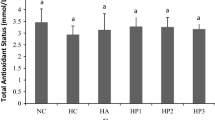Abstract
Hypercalciuria is an important risk factor in the aetiology of idiopathic urolithiasis and many treatment modalities in clinical practice are directed towards reducing urinary calcium excreation. There are no natural animal models of hypercalciuria, such as the spontaneous hypertensive rat; however, the streptozotocin-diabetic rat is accepted as a good model for studies of disordered renal function associated with diabetes mellitus. Hypercalciuria is a prominent feature of the streptozotocin-diabetic rat and the model was, therefore, used to study the influence of evening primrose oil on urinary clacium excretion. Twenty rats divided into two groups of ten rats each were maintained on either normal rat chow (group 1) or primrose oil enriched diet (group 2) for 10 weeks. At 4 weeks both groups of rats were made diabetic with streptozotocin. Urine calcium measurements were serially performed before commencement of the diet, during the pre-streptozotocin (pre-diabetic) phase and during the post streptozotocin (diabetic) phase. The urine calcium excretion was significantly less in the primrose oil fed animals during both the pre-diabetic phase and the diabetic phase compared with the rats on the normal rat chow. These results indicate that evening primrose oil, a rich source of γ-linolenic acid, helps to reduce urine calcium excretion in normal animals as well as in the hypercalciuric streptozotocin-diabetic rat. Dietary modifications with long-chain ω-6 and ω-3 fatty acids might be a useful adjunct in the treatment of idiopathic hypercalciuric urolithiasis.
Similar content being viewed by others
References
Backman U, Danielson BG, Johansson G, Ljunghall S, Wikstrom B (1979) Effects of therapy with bendroflumethiazide in patients with recurrent renal calcium stones. Br J Urol 51:175
Buck AC, Sampson WF, Lote CJ, Blacklock NJ (1981) The influence of renal prostaglandins on glomerular filtration rate and calcium excretion in urolithiasis. Br J Urol 53:485
Buck AC, Lote CJ, Sampson WF (1983) The influence of renal prostaglandins on urinary calcium excretion in idiopathic urolithiasis. J Urol 129:421
Buck AC, Lote CJ, Head S, Faulkner K (1988) Effect of insulin on renal function in streptozotocin-treated rats. In: Walker VR, Sutton RAL, Cameron ECB, Pak CYC, Robertson WG (eds) Urolithiasis Plenum, New York, p 359
Buck AC, Davies RL, Harrison T (1991) The role of eicosapentaenoic acid (EPA) in the pathogenesis of nephrocalcinosis. J Urol 146:188
Buck AC, Smellie WS, Jenkins A, Meddings R, Horrobin D (in press) The treatment of idiopathic recurrent urolithiasis with fish oil and evening primrose oil — a double blind study. In: Proceedings of the 7th International Symposium on Urolithasis and Related Research, 1993, Plenum, New York
El-Boustani S, Descomps B, Monnier L, et al (1986) In vivo conversion of dihomogammalinolenic acid into arachidonic acid in man. Prog Lipid Res 25:67
Garland HO, Singh HJ (1988) Effects of D-glucose, 2-deoxy D-glucose and D-xylose on renal function in the rat. J Physiol (Lond) 400:447
Henriquez-La Roche C, Rodriguez-Iturbe B, Parra G (1992) Increased urinary excretion of prostaglandin E2 in patients with idiopathic hypercalciuria is a primary phenomenon. Clin Sci 83:75
Hobarth K, Hofbauer J (1993) Limitations of metabolic evaluation in calcium urolithasis (abstract 15). Urol Res 21:145
Hoffman P, Mest H-J (1987) What about the effects of dietary lipids on endogenous prostanoid synthesis? State of the art review. Biomed Biochem Acta 46:639
Horrobin DF (1983) Gamma linolenic acid. In: Johnson S, Johnson FN (eds) Reviews in contemporary pharmacotherapy, vol 1. Marius, p 1, Lancaster
Horrobin DF (1991) Interactions between n-3 and n-6 essential fatty acids (EFAs) in the regulation of cardiovascular disorders and inflammation. Protaglandins Leukot Essent Fatty Acids 44:127
Hostetter TH, Troy JL, Brenner BM (1981) Glomerular haemodynamics in experimental diabetes mellitus. Kidney Int 19:410
Houser M, Zimmerman B, Davidman M, Smith C, Sinaiko A, Fish A (1984) Idiopathic hypercalciuria associated with hyperreninemia and high urinary prostaglandin E. Kidney Int 26:176
Hwang DH, Boudrea M, Chanmugam P (1988) Dietary linolenic acid and longer-chain n-3 fatty acids: comparison of effects on arachidonic acid and metabolism in rats. J Nutr 118:427
Jamal GA, Carmichael H (1990) The effect of γ-linolenic acid on human diabetic peripheral neuropathy: a double blind placebo controlled trial. Diabetic Med 7:319
Jensen PC, Steven K, Blaeher H, Christiansen JS, Parving H-H (1986) Effects of indomethacin on glomerular haemodynamics in experimental diabetes. Kidney Int 29:490
Jensen PK, Christiansen JS, Seven K, Parving H-H (1981) Renal function in stretozotocin-diabetic rats. Diabetologia 21:409
Laerum E, Larsen S (1982) Thiazide prophylaxis of urolithiasis: a double blind study in general practice. Acta Med Scand 215:383
Marshall V, White RH, Chaput de Saintonge M, Tresidder GC, Blandy JP (1975) The natural history of renal and ureteric calculi. Br J Urol 47:117
Mercuri O, Peluffo RO, Brenner RR (1966) Depression of microsomal desaturation of linoleic acid to gammalinolenic acid in aloxan-diabetic rat. Biochim Biophys Acta 116:409
Mikhailidis DP, Kirtland SJ, Barradas MA, et al (1986) The effect of dihomogammalinolenic acid on platelet aggregation and prostaglandin release, erythrocyte membrane fatty acids and serum lipids: evidence for defect in PGE1 synthesis and delta-5 desaturase activity in insulin dependent diabetics. Diabetes Res 3:7
Roy DR, Seely JF (1981) Effect of glucose on renal excretion of electrolytes in the rat. Am J Physiol 240:F17
Scholz D, Schwille PO, Sigel A (1982) Double-blind study with thiazide in recurrent calcium lithiasis. J Urol 128:903
Wood RJ, Allen LH (1983) Evidence for insulin involvement in arginine and glucose-induced hypercalciuria in the rat. J Nutr 113:1561
Author information
Authors and Affiliations
Rights and permissions
About this article
Cite this article
Tulloch, I., Smellie, W.S.A. & Buck, A.C. Evening primrose oil reduces urinary calcium excretion in both normal and hypercalciuric rats. Urol. Res. 22, 227–230 (1994). https://doi.org/10.1007/BF00541897
Received:
Accepted:
Issue Date:
DOI: https://doi.org/10.1007/BF00541897




